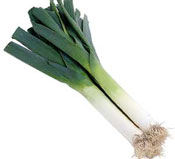

Leeks

Allium ampeloprsum variety porrum. Liliaceae (Alliaceae). A monocotyledonous biennial plant with long green leaves with white bases which form a tight cylinder. It is similar to the onion but leaves are flat and the plant does not normally form a distinct bulb. Wild relatives of leek occur in the eastern Mediterranean region and into western and southern Russia. Leek is adapted to a temperate climate and is able to withstand cold weather to a much greater extent than the onion. However, like the onion it is vernalised by cold temperature and subsequently bolts, making it unusable. Leeks are a hardy winter vegetable with a harvesting season extending from late summer until late spring the following year. They have a milder flavour than onion and are used as a cooked vegetable and in soups. Germination is optimum at soil temperatures between 11-23ºC but is drastically reduced at soil temperatures below 7ºC and above 27ºC. Cool conditions favour optimum growth and day temperatures greater than 24ºC may reduce yields. Under these temperature conditions leek does not develop a conspicuous bulb but under extreme long-day conditions (greater than 19 hours) at high latitudes bulbing may occur, particularly at a temperature of 15-18ºC. Leeks grow best in deep, well-cultivated soil into which well-rotted organic manure has been worked. Optimum soil pH is 6.5-7.5 and should be raised by liming if too acid. Soil temperatures should be at least 7ºC before sowing; the earliest crops should be raised from sowings in gentle heat under protection during early spring. These should be pricked out and hardened off before planting out. Early outdoor sowings can also be made under cloches in drills approximately 2cm deep. Spring sowings should be planted out during the summer when the seedlings are between 10-15 weeks old and are about 20cm tall. Longer leaves can be trimmed back slightly to facilitate planting and the seedbed should be watered well before lifting the seedlings. A number of cultivars should be used to provide a succession of croppings. Recommended spacing for optimum yield of average-sized leeks in rows 30cm apart with 15cm between plants within rows. Higher-density plantings will give similar yields of small, more slender leeks. 
The length of the blanched portion of leaf bases depends in part on the cultivar but can also be affected by the planting method. Several methods are aimed at increasing the proportion of blanched leaf. The simplest is to make 15cm-deep holes with a dibber into which individual plants are dropped. The holes should then be filled with water. The holes will gradually fill up as the season progresses, increasing the proportion of leaf excluded from light. An alternative approach is to plant into V-shaped drills 7.5cm deep which are later closed in around the plants to blanch the lower portion of the leaves . Plants can also be established on the flat and earthed up in a similar way several times during growth. Seeds can be sown direct into their final position but this makes weed control more difficult and the leeks are likely to have a reduced portion of blanched stem. Plants should be kept well watered and free from weed competition during growth. Leeks can be lifted as required and later cultivars can remain outside during the winter until late spring when plants will commence flowering and are no longer suitable for consumption. The early cultivars for harvesting during the late summer and autumn period tend to be taller, with longer white shafts and paler foliage of blanched stem and have darker leaves. Recommended cultivars include: (early) ‘Autumn Mammoth’, ‘Gennevilliers Splendid’, ‘King Richard’; (very long) ‘Swiss Giant-Pancho’; (mid-season)’ Argenta’, ‘Lyon’, ‘Lyon Prizetaker’; (late) ‘Blauwgroen Winter-Alaska (short and bulbous), ‘Catalina’, ‘Giant Winter’, ‘Giant Winter Royal Favourite’, ‘Goliath’, ‘Musselburgh’, ‘Snowstar’, ‘Wintra’, (‘Winterreuzen’). ‘Broad London’ or ‘Large Americam Flag’, and ‘Unique’ are recommended in the US for overwintering. Leek fanciers grow ‘pot leeks’ for exhibition and competition for maximum weight, using specialised cultural methods and home-saved seed strains. Leeks have many disease problems in common with onions; leaf blotch (Cladosporium allii), rust (Puccinia allii) and white tip (Phytophthora porri) are especially important. Symptoms of leaf blotch are as described for onion. The rust causes long leaf lesions containing red-brown urediospores. In white tip the leaves at first turn yellow at the tips and eventually become bleached and die; they may also rot at ground level. Plant debris should be destroyed to prevent the fungus oospores from contaminating the soil. Rust and white tip can be controlled with fungicide sprays.
|
Home
Grow Nuts
Grow Herbs
Grow Fruit
Cyberian Index
If you like this website and want one of your own contact
Cyberian All information correct at
time of publication and open to updates as necessary. No part of this website,
or its vectors, may be produced in any shape or form, using any type or design
of medium, system, equipment or otherwise without the prior written consensual
notice of the Cyberian. Any breach of these requirements will result in the
appropriate action. If in doubt, e-mail contact is recommended.
Some components of this website were obtained as open-source software and are
used in the same non-profit manner on this website.